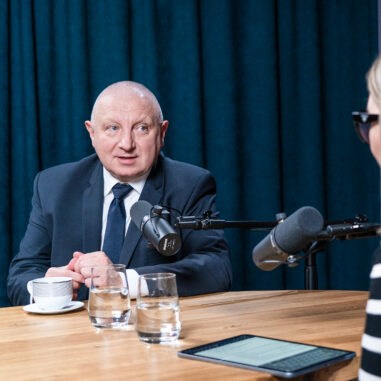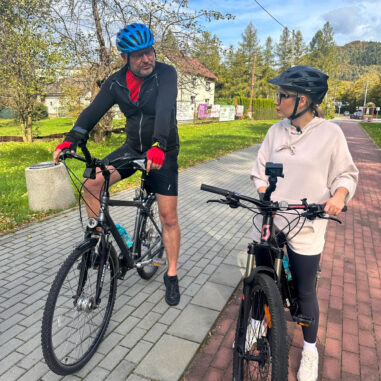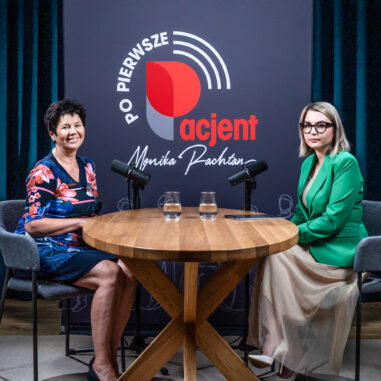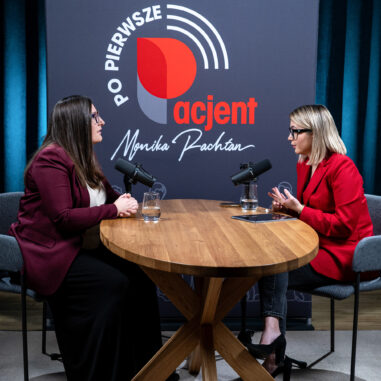
Medical marijuana and its therapeutic uses. Episode 29
It is now six years since medical marijuana became legal in Poland. A controversial drug treated by some as a means of intoxication, to others it serves as an excellent medicine for treating pain. In the latest episode of 'Po pierwsze Pacjent', Monika Rachtan talks to Dr Magdalena Nita, M.D., about medical marijuana therapy. Find out in which cases, for which conditions it can be used and what the treatment process looks like.
Medical cannabis is becoming an increasingly popular therapy in many countries, including Poland. Registered by the Office for Registration of Medicinal Products, Medical Devices and Biocidal Products, medical cannabis has been used to treat a variety of conditions since November 2017, yet this form of therapy continues to stir up controversy.
Differences between medical and relaxation cannabis
Cannabis, also known as hemp, is a plant used for both medicinal and relaxation purposes. Its history dates back thousands of years. Historically, it has been used in various cultures for its medicinal and intoxicating properties. Today, medical and relaxation cannabis differ significantly in terms of cultivation and quality.
Medical cannabis comes from special plantations where the cannabis is grown under controlled conditions, away from pesticides or heavy metals. Emphasis is placed on the quality and ratio of cannabinoids - the active substances in the plant. Each batch of dried cannabis must meet strict quality standards, and in Poland these standards are particularly high. Unlike relaxation cannabis, which often comes from less controlled sources, medical cannabis has to undergo a number of tests and studies before it can be approved for medical use.
The differences between medical cannabis and relaxation cannabis are not limited to quality and control of cultivation. Medical cannabis is mainly used for its medicinal properties, particularly in relieving pain. In contrast, relaxation marijuana, which is mostly used for its intoxicating effects, is often not subject to such strict controls and may contain various additives or impurities.
Medical cannabis therapy
Medical cannabis therapy in the context of the treatment of various conditions is becoming increasingly important, becoming a complement to conventional therapeutic methods. Registered by drug agencies in both the United States and Europe, medical cannabis is primarily used to treat chronic pain and in cases of neurodegenerative diseases such as multiple sclerosis. The guest of the episode emphasises that medical cannabis is primarily intended to alleviate discomfort associated with oncological and neurodegenerative diseases.
It is worth emphasising that medical cannabis is not a replacement treatment, but an adjunctive therapy. It does not replace standard treatments such as chemotherapy or immunotherapy, but can significantly improve patients' quality of life by reducing pain symptoms or spasticity (abnormal, increased muscle tension) . It is also worth noting that this therapy is individually tailored to the patient's needs. Different varieties of dried hemp, with different properties and content of active substances, allow the therapy to be precisely tailored to the patient's specific needs and expectations.
In Poland, where quality standards for medical cannabis are particularly strict, patients can be sure that they are receiving a high quality product. However, it should be borne in mind that the use of this therapy requires medical knowledge and experience and should therefore take place under the close supervision of specialists. Outpatient clinics such as the Centre for Cannabis Medicine, which are being established in Poland, offer support and education for both patients and doctors, which is an important step towards spreading knowledge about this form of therapy.
Prescription and what next?
The use of medical marijuana is a process that begins with receiving a prescription from a doctor. A prescription for medical marijuana, like other medicines, is filled at a pharmacy. It is advisable to check the availability of the product in pharmacies using online search engines before purchasing. The cost of medical marijuana therapy varies, but for an oncology patient using droughts regularly, the monthly cost can be around £650. The initial costs of the therapy include the purchase of medical cannabis and the necessary equipment to use it, such as a vaporiser, which is used for vaporisation.
Vaporisation is a process in which dried cannabis is heated to a suitable temperature, allowing the release of active ingredients without burning the plant material. This method is considered a safer alternative to smoking, as it does not release harmful tarry substances. Vaporisers are devices specially adapted to this process and can be purchased in pharmacies or specialised shops.
In the case of medical cannabis, it is important that patients are aware of the legality of this therapy, as long as they have the correct prescription and indications. Cannabis dried is sold in hermetically sealed packages, with a label and specifications, just like other medicines. The product leaflet contains all the necessary information, including the expiry date and cannabinoid ratio.
Disinformation and stigmatisation
Medical cannabis therapy is currently the subject of much discussion and controversy. Unfortunately, there is still a certain stereotype and lack of knowledge in Poland, both among patients and medical staff. On many occasions, patients experience unpleasant incidents from doctors, who accuse them of snatching cannabis for recreational purposes, or incorrectly assess the effectiveness of this therapy due to a lack of relevant experience and knowledge.
At the same time, there is a lot of misinformation circulating on the internet about medical marijuana, including false claims about its effectiveness in treating cancer. This leads to situations where patients, seeking help, are disappointed to learn that medical marijuana can only help relieve ailments, but is unable to fight cancer cells.
Emphasising a correct understanding of the role of medical cannabis is crucial. While it can help reduce pain and relieve some symptoms, it is not a primary therapy and does not replace traditional treatments such as chemotherapy or immunotherapy. For this reason, it is important that patients are properly informed and referred by professionals familiar with this therapy.
CBD oils
CBD oils in the context of alternative medicine are gaining popularity, but it is important to distinguish between them and medical marijuana. Unlike medical cannabis, which is a registered pharmaceutical commodity available by prescription and sold only in pharmacies, CBD oils found on the online market are often products of questionable quality and efficacy.
CBD, which is a cannabinoid, has therapeutic properties, but is non-psychoactive and safe to use. It has anti-inflammatory and relaxing effects, as well as influencing the immune system. Although CBD does not have the same broad spectrum of uses as medical cannabis, in its true form it is an effective addition to comprehensive therapy.
However, as Magdalena Nita points out, it is important for consumers to be aware and cautious. CBD products bought online may not only be ineffective, but also dangerous, as their composition and quality are unknown. At worst, they may contain harmful chemicals or even legal highs. Therefore, it is important to choose products from reliable and proven sources, paying attention to their composition and value for money.
Transcription
Monika Rachtan:
Did you know that medical marijuana is legal in Poland and only available by prescription? Did you know that there are special dispensaries for medical marijuana therapy? Medical marijuana relieves the symptoms of various diseases, but remember that it does not cure any condition. I will be discussing all this in the next episode of the programme "First Patient" with my guest Dr Magdalena Nita, a specialist from the Centre for Cannabis Medicine. I invite you to listen to our conversation.
Magdalena Nita:
Good morning, hon. Thank you for the invitation.
Monika Rachtan:
Magda, you work at the Centre for Hemp Medicine. What do you do there?
Magdalena Nita:
Yes, at the Centre for Cannabis Medicine we treat a wide range of ailments, including with medical marijuana therapy. This is an alternative when classical treatment does not work.
Monika Rachtan:
It seems to me that there is a lot of stigma around medical marijuana. People often have a negative perception of this treatment method, confusing it with relaxation marijuana. How do you perceive this?
Magdalena Nita:
Unfortunately, there is a stereotype and lack of knowledge among both patients and medical staff in Poland. Patients have reported to me instances of unpleasant treatment when talking about the use of medical marijuana therapy.
Monika Rachtan:
Have there been any instances of a doctor insulting patients or accusing them of snorting cannabis for recreational purposes?
Magdalena Nita:
Yes, there were different cases. Some patients felt rejected or stigmatised. There are also doctors who try to convince patients that the therapy does not work, despite their lack of relevant knowledge and experience.
Monika Rachtan:
Coming back to medical marijuana, it is different from relaxation marijuana. Can you tell us more about this difference?
Magdalena Nita:
The difference is significant. Medical marijuana comes from special plantations that are strictly controlled for quality and cannabinoid content. These plantations have to meet high quality standards and each country sets its own criteria for cannabinoid content.
Monika Rachtan:
Are these standards higher in Poland than in other countries?
Magdalena Nita:
Yes, our standards are very strict. Last year we had a problem because the medical drought did not meet these standards and patients were left without treatment for some time.
Monika Rachtan:
What do you do in such a situation?
Magdalena Nita:
We have to go back to classical treatments and wait for the appropriate medical droughts to appear in pharmacies.
Monika Rachtan:
And what do these special cannabis plantations look like?
Magdalena Nita:
Although I have not personally been to such a plantation, we work with companies that supply drought. These plantations have strict conditions, are protected from pesticides and heavy metals, have the right soil and are harvested at the right time. A strictly defined species of cannabis is grown there, which ensures greater control over quality.
Monika Rachtan:
So when it comes to safety, we can be sure that it is maintained. The high standards in Poland are very strict, so patients can rest assured that if they receive a prescription for medical marijuana therapy from a doctor, nothing bad will happen to them. For which conditions do you most commonly use such therapy?
Magdalena Nita:
I use it most often for pain therapy, especially chronic pain. It works very well in the treatment of complaints related to various oncological diseases. However, I must point out that it is an adjunctive therapy and not a replacement for the main treatment.
Monika Rachtan:
So it does not replace chemotherapy or immunotherapy, which are prescribed by clinical oncologists?
Magdalena Nita:
Exactly. It is important to point out that some patients, misinformed by the media, think that medical marijuana cures cancer, but unfortunately we have to disappoint them. Medical cannabis only alleviates the discomfort, it does not cure the disease itself.
Monika Rachtan:
You talked about oncology patients. Are there other patient groups that benefit from this therapy, such as patients with neurological diseases?
Magdalena Nita:
Of course. Medical marijuana is used to treat neurodegenerative diseases such as multiple sclerosis. It helps to reduce spasticity. However, it is worth remembering that it is not a first-line therapy. This does not mean that medical cannabis will become a cure-all for all diseases, replacing classical drug treatment.
Monika Rachtan:
Often patients do not inform the doctor about their pain complaints. They say that the doctor is not treating them effectively, even though they continue to feel pain. How do you deal with such situations?
Magdalena Nita:
I have noticed that both medical staff and patients often justify pain by claiming that it is normal after surgery, with cancer or other illnesses. Every patient deserves an adequate quality of life and function, so we have mechanisms to treat pain and combine therapies.
Monika Rachtan:
Is there a distinction in the types of medical cannabis used for different diseases, for example in oncology versus other conditions?
Magdalena Nita:
The differentiation is quite complex. There are many types of dried hemp, and their composition and properties depend on their content of cannabinoids, terpenes and flavonoids. Treatment is therefore very individual and personalised. Patients have different expectations and needs, so we select the right dried product. Medical cannabis therapy is the beginning of the treatment pathway and patients should be guided by specialists who are familiar with this therapy.
Monika Rachtan:
Are there many cannabis dispensaries in Poland?
Magdalena Nita:
We are not the only ones. More and more facilities of this type are being set up. Doctors are interested in learning about this form of therapy, so we also provide training for doctors so that they can refer patients to the appropriate clinics. Not every doctor is aware of this form of treatment.
Monika Rachtan:
Can any doctor write a prescription for medical marijuana therapy?
Magdalena Nita:
Yes, any doctor, except a veterinarian, can do this. However, getting droughts is only the beginning of the treatment. It is important that patients are managed by specialists who know how to dose the drug and how to titrate it.
Monika Rachtan:
Before discussing the path of a patient who has received a prescription for medical marijuana therapy, I want to ask about products advertised on the internet. I often come across incentives to buy products containing cannabis, but they are not on prescription and promise to cure various ailments. What is your opinion on this and how do they differ from medical marijuana?
Magdalena Nita:
First of all, it is important to remember that medicines cannot be advertised, so this alone should alert us. The products you are talking about are often ineffective and are only created to deceive patients. Medical cannabis is a registered pharmaceutical raw material, only available from a pharmacy by prescription. In the case of advertised products, at best you get cannabis oil that mimics CBD extract. CBD oils have some therapeutic properties, but are not as effective as medical marijuana. Be careful and do not fall for false promises.
Monika Rachtan:
I am also thinking about the safety of such products bought on the internet. We do not know what we are actually taking into our mouths. Medical marijuana is subjected to rigorous testing, and we cannot say that about products from the Internet.
Magdalena Nita:
Exactly, they can even be chemical compounds or boosters. That is why I warn against buying such products.
Monika Rachtan:
What about driving during medical marijuana therapy?
Magdalena Nita:
Unfortunately, due to the presence of THC in medical cannabis products, driving is not recommended. All products with THC are treated like other psychoactive substances. I recommend using public transport or walking during therapy.
Monika Rachtan:
Let's talk about prescription fulfilment. Where should the patient go after receiving the prescription?
Magdalena Nita:
After receiving the prescription, the patient goes to the pharmacy, just like any other prescription. However, it is worth checking the availability of the product on websites. Therapy can be expensive, especially at the beginning when the patient has to purchase medical marijuana and a vaporiser if he or she chooses to vaporise.
Monika Rachtan:
What is the average monthly cost of such therapy?
Magdalena Nita:
The cost is around 650 PLN per month for daily use by oncology patients. For other conditions, where cannabis is used less frequently or in combination with other medicines, the cost may be lower.
Monika Rachtan:
I will immediately ask about the methods of administering medical cannabis, but first I would like to raise the question of cost. The cost of a month's therapy can be around six hundred zloty. Do you think there should be reimbursement for medical marijuana in some cases?
Magdalena Nita:
Yes, I am in favour of introducing reimbursement. Every meeting and speech we have serves to make patients and decision makers aware of the need for reimbursement, especially in certain cases. I hope that in the future this drought will be reimbursed, and that awareness is growing every year.
Monika Rachtan:
Okay, let's return to the patient who has just filled a prescription at the pharmacy. What products will he find in his bag when he gets home?
Magdalena Nita:
Cannabis seed sold in pharmacies is not to be expected in unusual packaging. It is packaged in disposable plastic boxes with a label, expiry date and other information. The packaging is hermetically sealed to protect the product from oxidation.
Monika Rachtan:
What do you think can be done to reduce the stigma of medical marijuana users?
Magdalena Nita:
The key is education. Knowledge about medical cannabis needs to be popularised among both patients and medical staff. The more information, the less stigma.
Monika Rachtan:
Have you faced stigma from colleagues who think you are doing the wrong thing?
Magdalena Nita:
At the beginning of our work at the Centre for Hemp Medicine, I encountered some misunderstandings. In the hospital, talking about my additional work, there were unfavourable comments. However, over time, as knowledge about medical cannabis expanded, such behaviour began to fade.
Monika Rachtan:
Now that the patient has come home with a box of medical marijuana, what should he do? Does he or she need to burn the drought?
Magdalena Nita:
No, medical marijuana therapy is not based on smoking. We use vaporisation, i.e. heating the dried product instead of burning it. This is a healthier method because less tar is released. For vaporisation, we use a special device that allows us to set the right temperature.
Monika Rachtan:
Are vaporisers available in pharmacies?
Magdalena Nita:
Unfortunately, vaporisers are rarely available in pharmacies and are more often purchased online. It is important to choose a medically approved model, although these are more expensive. However, the performance of all vaporisers is similar.
Monika Rachtan:
Can a patient become addicted to medical marijuana therapy?
Magdalena Nita:
The potential for addiction to medical marijuana is low, similar to caffeine or alcohol. Of course, we do not promote its use among minors. Doctors should monitor therapy, paying attention to the body's tolerance to active substances. Dosage control by an experienced doctor is important.
Monika Rachtan:
Apart from the fear of stigmatisation, what concerns do patients have when they receive a prescription for medical marijuana?
Magdalena Nita:
Patients are concerned about whether the therapy is safe and whether it interacts with other medicines. We always recommend consulting a doctor who will verify any contraindications and assess the safety of cannabis use.
Monika Rachtan:
How do you respond to the arguments of opponents of medical marijuana therapy?
Magdalena Nita:
The main objection is the lack of extensive clinical trials. I reply that we rely on evidence-based medicine and experience. Although there are fewer studies, medical cannabis shows efficacy in practice. I also emphasise that it is not a first-line therapy and is only used when certain medical criteria are met.
Monika Rachtan:
Can medical cannabis be used in children?
Magdalena Nita:
It is not used in the home setting. In exceptional cases, such as drug-resistant epilepsy, the therapy has been carried out under the supervision of doctors in clinics. However, this is not standard practice.
Monika Rachtan:
Is it possible to overdose on medical marijuana?
Magdalena Nita:
Yes, but overdoses are not associated with such serious consequences as with other drugs, such as morphine. Symptoms of an overdose may include impaired coordination, drowsiness or vomiting, but are less dangerous than overdoses of other substances.
Monika Rachtan:
What side effects do patients most commonly report?
Magdalena Nita:
The most common are drowsiness and stimulation of appetite. In some cases, nausea, tachycardia or a drop in blood pressure may occur.
Monika Rachtan:
What are the three most important things for listeners of our programme to remember?
Magdalena Nita:
Firstly, let's not stigmatise medical marijuana users. Secondly, if in doubt, seek medical advice. And third, pain is not something we have to put up with - there are effective treatments.
Previous episodes

The importance of vaccination in the fight against viruses. Episode 28
Immunisation is a key element in building up immunity, especially during the autumn and winter season when our bodies are more vulnerable to various infections

Cholesterol - friend or foe? Episode 27
High cholesterol, uncontrolled by proper diet and treatment, can lead to serious cardiovascular problems such as stroke and heart attack.

How long is the wait for a sanatorium? Surprise! A few months. Episode 26
When thinking about a rehabilitation trip, many people wonder whether a sanatorium on the National Health Fund is as good as one we can pay for ourselves.

Nicotine is addictive and cigarette smoke kills. Episode 25
In Poland, as in other countries, interest in alternative methods of smoking is growing, It is an important public health issue and understanding patients' needs and addictions is crucial in the process of quitting smoking and reducing the risk of

Short-sightedness in children. Why is slowing its progression so important? Episode 24
Regular visits to the ophthalmologist are an important part of the prevention of visual impairment. The programme's guests emphasise that it is always a good time to see an ophthalmologist, even if there is nothing worrying going on




